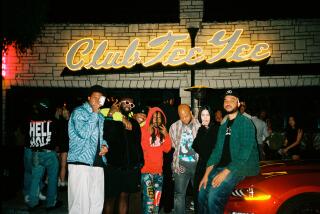‘Cuba 1959’: Burt Glinn’s defining photos of revolution sat unpublished for nearly 60 years
- Share via
On December 31, 1958, photojournalist Burt Glinn was at a New Year’s Eve party on the Upper West Side of Manhattan, where all the talk was about the impending fall of Cuban dictator Fulgencio Batista. The idea that Batista’s regime might fall at any second spurred the young Glinn, then an independent photographer, into action. He hit up his colleagues at the party for any cash they had on hand, went home to change out of his tuxedo and caught the first flight he could find to Havana.
For 10 days he took pictures: of the airport surrounded by tanks, of ad hoc militias in support of the Revolution (some of them in pajamas) taking over Havana, of the barbudos (the bearded ones) rolling into Santa Clara, and of revolutionary leader Fidel Castro delivering one of his early epic speeches. In between he captured the people of Cuba, with looks of elation, fear and bewilderment.
These images — the majority of which never before have been seen — are now gathered in the book “Cuba 1959,” released this month by Reel Art Press.
“A lot of photographs of a special event, they are taken by someone who happens to be there, but they’re not magical as photographs,” says Tony Nourmand, editor-in-chief of Reel Art Press, and co-editor of Glinn’s book. “But Burt’s work is so incredible. It’s really modern. You can practically smell the streets. And it was all done on the hop — running from the plane, running into the streets, he gives you the whole overview, but with a real sense of composition.”
Glinn, an independent photographer for the prestigious Magnum agency, passed away in 2008, but left behind a formidable archive. In his life, he photographed subjects as diverse as Soviet leader Nikita Kruschev and the country of Japan. Among the many pictures he made over the course of his life was a vast trove of images on Cuba — including those from the Revolution.
“We went to visit his widow, [Elena Prohaska], and we came across these photo essays that were really comprehensive,” Nourmand says. “I couldn’t believe my eyes. And I couldn’t believe that some of them had never been published.”
The fact that some of the images haven’t been seen before may have something to do with the off-the-cuff way in which Glinn approached this particular story.
Burt’s work is so incredible. It’s really modern. You can practically smell the streets. And it was all done on the hop.
— Tony Nourmand, co-editor “Cuba 1959”
“He was at a dinner party in New York at 10 p.m.,” Nourmand says. “And the next morning at 7 a.m. he’s in Havana, Cuba, looking for Fidel Castro. And mind you, this was not an assignment where he was getting paid.”
Glinn went to Cuba simply out of a photojournalist’s sense of curiosity.
“Contrary to the romantic misconceptions about the job, I was not particularly brave,” he once wrote in an essay that is now featured in the book. “I really hated it when people I did not know began shooting at me.”
The opportunity to capture history in the making, however, proved too great a lure.
“Fidel Castro had been an outlaw and a rebel in the Sierra Maestra for a couple of years,” Glinn wrote. “If you made the right connections and did not mind sleeping on the ground, he was reachable by the press...”
“If you look at the captions in the book, you’ll see that he says that things got so crazy that he lost a camera and his shoes — so he was running around Havana barefoot,” Nourmand says. “That’s the difference between a real photojournalist and someone posting stuff on their iPhone. It’s not just being there. It’s having a knack for it, a feel for it.”
Nourmand says that “Cuba 1959” will not be the last Glinn book we can expect to see. (“When you look at the depth of his archive, we could publish a book a year,” he says.) Nourmand is now at work on a “The Beat Scene,” another Glinn title due to be published in September 2016.
“We found 400 color slides of pictures he took of the Beat Generation,” he says. “They’ve never been seen before. They’ve just been sitting in a drawer.”
“Cuba 1959” ($60) by Burt Glinn is avalable from Reel Art Press.
Find me on Twitter @cmonstah.
More to Read
The biggest entertainment stories
Get our big stories about Hollywood, film, television, music, arts, culture and more right in your inbox as soon as they publish.
You may occasionally receive promotional content from the Los Angeles Times.











